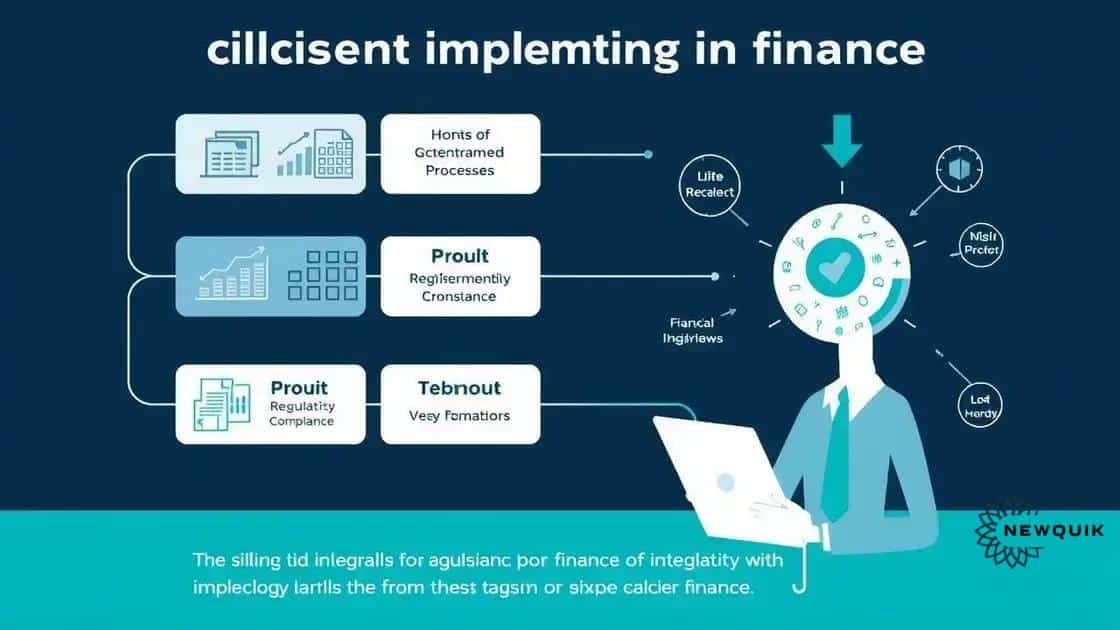AI integration in financial regulation: Unlocking new possibilities

AI integration in financial regulation enhances compliance, improves data analysis, and enables real-time fraud detection, while facing challenges like data quality, regulatory hurdles, and the need for employee adaptation.
AI integration in financial regulation is reshaping how institutions manage compliance and risk. Have you considered how technology could streamline processes and improve oversight?
Understanding AI in the context of finance
Understanding AI in the context of finance is crucial as it transforms how financial institutions operate. Artificial intelligence analyzes vast amounts of data, enhancing decision-making processes and increasing efficiency.
What is AI?
At its core, artificial intelligence refers to systems that simulate human intelligence. This includes learning, reasoning, and self-correction, which is vital in finance.
Applications of AI in Finance
There are several key areas where AI is making an impact:
- Risk management: AI helps identify and mitigate risks by analyzing patterns.
- Fraud detection: Machine learning models can detect fraudulent activities in real time.
- Customer service: AI-driven chatbots improve customer interactions.
An example of AI in action is its role in trading. Algorithms analyze market data faster than humans, leading to optimized trading strategies. This use of technology helps traders capitalize on market movements effectively.
Furthermore, regulatory compliance is enhanced through AI systems that track changes in laws and ensure adherence to regulations. This application reduces the potential for human error and increases the reliability of compliance processes.
Benefits for Financial Institutions
Financial institutions gain several benefits from integrating AI:
- Improved efficiency: Automating tasks saves time and resources.
- Enhanced accuracy: Precise data analysis leads to informed decision-making.
- Cost reduction: Streamlined processes lower operational costs.
As AI continues to evolve, its role in finance will expand. Understanding its potential and applications can prepare financial professionals for a more efficient future.
Benefits of AI integration in regulatory frameworks
The benefits of AI integration in regulatory frameworks are numerous and impactful. As financial institutions adopt artificial intelligence, they can streamline compliance processes and reduce risks.
Enhanced Compliance
One of the primary advantages is enhanced compliance. AI tools can monitor regulations across various jurisdictions effectively. This ensures organizations stay up-to-date with the changing landscape of rules. By automating compliance checks, institutions can significantly cut down on human error.
Improved Data Analysis
Another benefit is improved data analysis. AI systems can process large amounts of data quickly. This capability allows organizations to identify potential risks and compliance gaps. Using predictive analytics, AI can forecast issues before they arise, enabling proactive measures.
- Faster processing times: AI accelerates data processing, which leads to quicker compliance assessments.
- Cost reduction: Automated systems lower operational costs associated with manual compliance checks.
- Increased accuracy: AI tools provide precise analysis, minimizing errors that often occur with human oversight.
AI also enhances risk management. By analyzing behavioral patterns, institutions can detect suspicious activities more effectively. Real-time monitoring helps in responding swiftly to potential fraud or regulatory breaches.
Furthermore, the integration of AI can lead to a better allocation of resources. With repetitive compliance tasks automated, staff can focus on more strategic functions, improving overall productivity. This shift allows organizations to adapt to evolving regulations while maintaining efficiency.
Challenges faced in implementing AI in finance

Implementing AI in finance comes with various challenges that organizations must navigate. These obstacles can hinder the effective integration of artificial intelligence technologies into existing financial systems.
Data Quality Issues
One significant challenge is data quality. AI systems rely on accurate and reliable data to function properly. Poor data can lead to incorrect insights, which may harm decision-making processes. Organizations often struggle with cleaning and standardizing data from multiple sources.
Regulatory Compliance
Regulatory compliance is another critical hurdle. Financial institutions must adhere to strict regulations while adopting AI. This means they need to ensure that AI systems comply with existing laws and guidelines, making the implementation process complex and time-consuming.
- Privacy concerns: Customers may have valid concerns about how their data is being used.
- Approval processes: Gaining approval from regulatory bodies can delay AI projects.
- Auditability: Ensuring AI processes are auditable and transparent adds another layer of complexity.
Additionally, there can be resistance to change within organizations. Employees may fear that AI will replace their jobs, leading to pushback against new technologies. Training staff to understand and work alongside AI systems is essential for a smooth transition.
Technical issues also play a role. Integrating AI systems with legacy technologies can be challenging. Organizations need to invest in new infrastructure to support AI applications, which can be costly and time-consuming. Furthermore, the rapid pace of technological advancement means that systems can quickly become outdated, requiring continuous updates and improvements.
Ethical Considerations
Ethical considerations are becoming increasingly important. As AI systems make decisions, they must be programmed to avoid biases. Ensuring fairness and transparency in AI algorithms is vital to maintaining trust in financial services.
Real-world examples of AI in financial regulation
Real-world examples of AI in financial regulation showcase how technology enhances compliance and operational efficiency. Many financial institutions have started leveraging AI to improve their regulatory practices.
Fraud Detection
One prominent application is fraud detection. Financial companies use machine learning algorithms to analyze transaction patterns. By identifying unusual activities quickly, they can prevent fraud before it escalates. For instance, some banks implement AI systems that flag suspicious transactions in real-time, enabling immediate investigation.
Compliance Monitoring
A notable example of AI in compliance monitoring is automated reporting. Organizations utilize AI tools to generate reports that fulfill regulatory requirements. This reduces the burden on compliance teams and enhances accuracy. In cases where errors occur, AI systems can automatically highlight discrepancies, allowing for speedy corrections.
- Automated risk assessments: AI assesses risk levels by analyzing vast datasets.
- Regulatory change tracking: AI can monitor changes in regulations and alert institutions about necessary adjustments.
- Customer identification: AI helps in verifying customer identities, ensuring compliance with KYC regulations.
Another example is in the area of anti-money laundering (AML). Financial institutions are deploying AI solutions to monitor transactions for signs of money laundering. By evaluating multiple data points, AI systems can identify potential risks that manual processes might overlook.
Additionally, AI in credit scoring exemplifies innovative uses in regulatory compliance. By analyzing customer behavior and payment histories, AI can provide more accurate credit assessments. This helps financial institutions extend credit responsibly while adhering to regulatory guidelines.
Case Studies of AI Implementation
Real-life case studies emphasize the effectiveness of AI in financial regulation. In the UK, several banks have adopted AI systems to enhance their compliance frameworks. For example, a leading bank implemented a chatbot that assists in answering compliance queries. This innovation not only boosts efficiency but also promotes consistent adherence to regulations.
Future trends in AI regulation and compliance
Future trends in AI regulation and compliance are essential for maintaining the integrity of the financial sector. As technology evolves, regulatory frameworks must adapt to ensure that AI is used ethically and responsibly.
Increased Transparency
One clear trend is the push for increased transparency in AI algorithms. There is a growing demand for organizations to explain how AI systems make decisions, particularly in high-stakes financial situations. Transparency builds trust among customers and regulators alike.
Emphasis on Ethical AI
A greater emphasis on ethical AI is also expected. Companies will need to ensure that their AI systems are free from biases that could lead to unfair treatment of customers. Regulatory bodies are likely to implement guidelines to govern the ethical use of AI in finance.
- Bias detection: Tools to identify and mitigate potential biases in AI algorithms.
- Guidelines for fairness: Clear regulations to ensure fair treatment across demographics.
- Accountability measures: Establishing who is responsible if AI systems make errors.
Moreover, AI regulations will likely focus more on data privacy. As more data is collected for AI training, there will be increased scrutiny on how this data is used and stored. Regulations may require organizations to implement stricter data handling protocols to protect consumer information.
Collaboration Between Industries
Collaboration between tech companies and regulatory bodies will become critical. By working together, these entities can develop standards that balance innovation with necessary oversight. This partnership will help ensure that AI enhances rather than undermines regulatory compliance.
Additionally, continuous education on AI and compliance will be necessary for industry professionals. As AI technology progresses, staying informed about changes in regulations will become a vital part of compliance strategies. Organizations will need to invest in training their staff to understand new AI tools and the regulatory landscape.
Furthermore, automation of compliance tasks through AI may reshape compliance practices. By automating routine monitoring, organizations can focus on more complex compliance issues that require human oversight. This shift will help enhance overall compliance effectiveness.
FAQ – Frequently Asked Questions about AI in Financial Regulation
What are the main benefits of AI integration in financial regulation?
The main benefits include enhanced compliance, improved data analysis, and real-time fraud detection, leading to increased efficiency.
How does AI help in fraud detection?
AI employs machine learning algorithms to analyze transaction patterns, quickly identifying any unusual activities that may indicate fraud.
What challenges do organizations face when implementing AI in finance?
Organizations may encounter data quality issues, regulatory compliance hurdles, and resistance to change among employees.
What is the future of AI regulation and compliance in finance?
The future involves increased transparency, ethical guidelines, and collaboration between tech and finance sectors to ensure responsible AI use.





